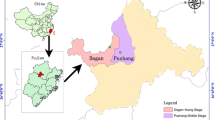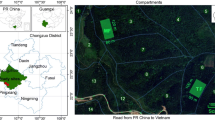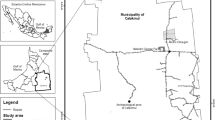Abstract
Mixed-species forests have potentially more benefits than monocultures particularly in terms of greater carbon sequestration. A 16-year-old Chinese fir (Cunninghamia lanceolata) monoculture in Zhejiang, China, was converted to a Chinese fir—broadleaved plantation by thinning from below (TFB) and crop tree release (CTR) methods coupled with planting of Chinese sweet gum (Liquidambar formosana) seedlings. Carbon pools in trees, snags, shrubs and herbs, seedlings, litterfall, forest floor, and mineral soil were measured for 5 years. The total tree biomass carbon increase in un-thinned control and CTR stands was approximately 15% higher than that in TFB. The average individual tree biomass C stock increased by 20.5% and 9.2% in CTR and TFB, respectively. Carbon flux through litterfall decreased after thinning but recovered, thereafter, to a level similar in the un-thinned control. Compared to the control, lower tree mortality and higher growth of seedlings in both converted stands resulted in no change in ecosystem C stocks. Carbon stocks in trees and seedlings increased more in CTR than in TFB stands, implying that CTR should be favored when converting pure plantations into mixed-species stands.







Similar content being viewed by others
References
Agren GI, Knecht MF (2001) Simulation of soil carbon and nutrient development under Pinus sylvestris and Pinus contorta. For Ecol Manag 141:117–129
Binkley D (2003) Seven decades of stand development in mixed and pure stands of conifers and nitrogen-fixing red alder. Can J For Res 33:2274–2279
Blanco JA, Imbert JB, Castillo FJ (2006) Influence of site characteristics and thinning intensity on litterfall production in two Pinus sylvestris L. forests in the western Pyrenees. For Ecol Manag 237:342–352
Campbell J, Alberti G, Martin J, Law BE (2009) Carbon dynamics of a ponderosa pine plantation following a thinning treatment in the northern Sierra Nevada. For Ecol Manag 257:453–463
de Wit HA, Kvindesland S (1999) Carbon stock in Norwegian forest soils and effects of forest management on carbon storage. Rapport fra skogforskingen—Supplement 14. The Norwegian Forest Research Institute (NISK), Oslo, Norway
Eggleston HS, Buendia L, Miwa K, Ngara T, Tanabe K (2006) IPCC guidelines for national greenhouse gas inventories. Institute for Global Environmental Strategies (IGES), Hayama. Volume 2. Energy
Epron D, Nouvellon Y, Mareschal L, Moreira RM, Koutika LS, Geneste B, Bouillet JP (2013) Partitioning of net primary production in Eucalyptus and Acacia stands and in mixed-species plantations: two case-studies in contrasting tropical environments. For Ecol Manag 301:102–111
Finkral AJ, Evans AM (2008) The effects of a thinning treatment on carbon stocks in a northern Arizona ponderosa pine forest. For Ecol Manag 255:2743–2750
Finzi AC, Van Breemen N, Canham CD (1998) Canopy tree-soil interactions within temperate forests: species effects on soil carbon and nitrogen. Ecol Appl 8:440–446
Forrester DI, Tang X (2016) Analysing the spatial and temporal dynamics of species interactions in mixed-species forests and the effects of stand density using the 3-PG model. Ecol Model 319:233–254
Forrester DI, Bauhus J, Cowie AL (2006a) Carbon allocation in a mixed-species plantation of Eucalyptus globulus and Acacia mearnsii. For Ecol Manage 233:275–284
Forrester DI, Cowie AL, Bauhus J, Wood J, Forrester RI (2006b) Effects of changing the supply of nitrogen and phosphorus on growth and interactions between Eucalyptus globulus and Acacia mearnsii in a pot trial. Plant Soil 280:267–277
Fule PZ, Waltz AEM, Covington WW, Heinlein TA (2001) Measuring forest restoration effectiveness in reducing hazardous fuels. J For 99:24–29
Gagne L, Sirois L, Lavoie L (2016) Comparison of volume and value of resinous wood from thinning from below and by releasing Elite Trees in Eastern Canada. Can J For Res 40(11):1320–1329
Garciagonzalo J, Peltola H, Briceno-Elizondo E, Kellomäki S (2007) Changed thinning regimes may increase carbon stock under climate change: a case study from a Finnish boreal forest. Clim Change 81:431–454
Ge ZM, Kellomäki S, Peltola H, Zhou X, Wang KY, Väisänen H (2011) Effects of varying thinning regimes on carbon uptake, total stem wood growth, and timber production in Norway spruce (Picea abies) stands in southern Finland under the changing climate. Ann For Sci 68(2):371–383
Gonzalez-Benecke CA, Martin TA, Cropper WP, Bracho R (2010) Forest management effects on in situ and ex situ slash pine forest carbon balance. For Ecol Manag 260:795–805
Hoover C, Stout S (2007) The carbon consequences of thinning techniques: stand structure makes a difference. J For 105:266–270
Huebschmann MM, Lynch TB, Wittwer RF (1999) Needle litterfall prediction models for even-aged natural shortleaf pine (Pinus echinata Mill.) stands. For Ecol Manag 117:179–186
Jactel H, Goulard M, Menassieu P, Goujon G (2002) Habitat diversity in forest plantations reduces infestations of the pine stem borer Dioryctria sylvestrella. J Appl Ecol 39:618–628
Jandl R, Lindner M, Vesterdal L, Bauwens B, Baritz R, Hagedorn F, Byrne KA (2007) How strongly can forest management influence soil carbon sequestration? Geoderma 137:253–268
Jobbagy EG, Jackson RB (2001) The distribution of soil nutrients with depth: global patterns and the imprint of plants. Biogeochemistry 53:51–77
Kelty MJ (2006) The role of species mixtures in plantation forestry. For Ecol Manag 233:195–204
Keyser TL (2010) Thinning and site quality influence aboveground tree carbon stocks in yellow-poplar forests of the southern Appalachians. Can J For Res 40:659–667
Keyser TL, Zarnoch SJ (2012) Thinning, age, and site quality influence live tree carbon stocks in upland hardwood forests of the southern Appalachians. For Sci 58:407–418
Kim C, Son Y, Lee WK, Jeong J, Noh NJ (2009) Influences of forest tending works on carbon distribution and cycling in a Pinus densiflora S. et Z. stand in Korea. For Ecol Manag 257:1420–1426
Knoke T, Ammer C, Stimm B, Mosandl R (2008) Admixing broadleaved to coniferous tree species: a review on yield, ecological stability and economics. Eur J For Res 127:89–101
Lee J, Morrison IK, Leblanc JD, Dumas MT, Cameron DA (2002) Carbon sequestration in trees and regrowth vegetation as affected by clearcut and partial cut harvesting in a second growth boreal mixedwood. For Ecol Manag 169:83–101
Liu WW, Xiang WH, Tian DL, Yan WD (2010) General allometric equations for estimating Cunninghamia lanceolata tree biomass on large scale in southern China. J Cent South Univ For 30:7–14 (in Chinese)
López-Serrano FR, Rubio E, Dadi T, Moya D, Andrés-Abellán M, García-Morote FA, Miettinen H, Martínez-García E (2016) Influences of recovery from wildfire and thinning on soil respiration of a Mediterranean mixed forest. Sci Total Environ 573:1217–1231. https://doi.org/10.1016/j.scitotenv.2016.03.242
Lu YC (2006) Theory and practice of close to nature forest management. Science Press, Beijing (in Chinese)
Marqus DA, Ernst RL (1991) The effects of stand structure after thinning on the growth of an Allegheny hardwood stand. For Sci 37(4):1182–1200
Miller GW, Stringer JW (2004) Effect of crown release on tree grade and dbh growth of white oak sawtimber in eastern Kentucky. In: Proceedings: 14th central hardwood forest conference, pp 27–44
Nave LE, Vance ED, Swanston CW, Curtis PS (2010) Harvest impacts on soil carbon storage in temperate forests. For Ecol Manag 259:857–866
Nichols JD, Bristow M, Vanclay JK (2006) Mixed-species plantations: prospects and challenges. For Ecol Manag 233:383–390
Nowak CA (1996) Wood volume increment in thinned, 50-to 55-year-old, mixed-species Allegheny hardwoods. Can J For Res 26:819–835
Parrotta JA, Knowles OH (1999) Restoration of tropical moist forests on bauxite-mined lands in the Brazilian Amazon. Restor Ecol 7:103–116
Piotto D (2008) A meta-analysis comparing tree growth in monocultures and mixed plantations. For Ecol Manag 255:781–786
Pretzsch H, Biber P, Uhl E, Dauber E (2015) Long-term stand dynamics of managed spruce–fir–beech mountain forests in Central Europe: structure, productivity and regeneration success. For Int J For Res 88(4):407–428
Pretzsch H, Del Río M, Schütze G, Ammer CH, Annighöfer P, Avdagic A, Barbeito I, Bielak K, Brazaitis L, Coll L, Drössler L, Fabrika M, Forrester DI, Kurylyak V, Löf M, Lombardi F, Matović B, Mohren F, Motta R, den Ouden J, Pach M, Ponette Q, Skrzyszewski J, Sramek V, Sterba H, Svoboda M, Verheyen K, Zlatanov T, Bravo-Oviedo A (2016) Mixing of Scots pine (Pinus sylvestris L.) and European beech (Fagus sylvatica L.) enhances structural heterogeneity, and the effect increases with water availability. For Ecol Manag 373:149–166
Profft I, Mund M, Weber GE, Weller E, Schulze ED (2009) Forest management and carbon sequestration in wood products. Eur J For Res 128:399–413
SFAPRC (State Forestry Administration, P.R. China) (2014) Statistics of Forest Resources in China (2009–2013). China Forestry Publishing House, Beijing
Simard SW, Blenner-Hassett T, Cameron IR (2004) Pre-commercial thinning effects on growth, yield and mortality in even-aged paper birch stands in British Columbia. For Ecol Manag 190:163–178
Simonin K, Kolb TE, Montes-Helu M, Koch GW (2006) Restoration thinning and influence of tree size and leaf area to sapwood area ratio on water relations of Pinus ponderosa. Tree Physiol 26:493–503
Simonin K, Kolb TE, Montes-Helu M (2007) The influence of thinning on components of stand water balance in a ponderosa pine forest stand during and after extreme drought. Agric For Meteorol 143:3–43
Skovsgaard JP (2009) Analysing effects of thinning on stand volume growth in relation to site conditions: a case study for even-aged Sitka spruce (Picea sitchensis (Bong.) Carr.). Forestry 82:87–104
Slodicak M, Novak J, Skovsgaard JP (2005) Wood production, litter fall and humus accumulation in a Czech thinning experiment in Norway spruce (Picea abies (L.) Karst.). For Ecol Manag 209:157–166
Song XZ, Chen XF, Zhou GM, Jiang H, Peng CH (2017) Observed high and persistent carbon uptake by Moso bamboo forests and its response to environmental drivers. Agric For Meteorol 247:467–475
Strukelj M, Brais S, Paré D (2015) Nine-year changes in carbon dynamics following different intensities of harvesting in boreal aspen stands. Eur J For Res 134:737–754
Wang Q, Wang S, Zhang J (2009) Assessing the effects of vegetation types on carbon storage fifteen years after reforestation on a Chinese fir site. For Ecol Manag 258(7):1437–1441
Wang YX, Zhang SG, Lu YC, Meng JH, Zeng J (2014) Initial Effects of crop trees growth after crop Tree release on Pinus massoniana plantation. Scientia Silvae Sinicae 50(10):67–73
Wang YX, Zhu XD, Bai SB, Zhu TT, Qiu WT, You YJ, Wu MJ, Berninger F, Sun ZB, Zhang H, Zhang XH (2018) Effects of forest regeneration practices on the flux of soil CO2 after clear-cutting in subtropical China. J Environ Manag 212:332–339
Weiskittel AR, Hann DW, Kershaw JA Jr, Vanclay JK (2011) Forest growth and yield modeling. Wiley, Chichester, p 193
Wu JQ, Wang YX, Yang Y, Zhu TT, Zhu XD (2014) Effects of crop tree release on stand growth and stand structure of Cunninghamia lanceolata plantation. Chin J Appl Ecol 26(2):340–348
Zhang XQ, Kirschbaum MUF, Hou ZH, Guo ZH (2004) Carbon stock changes in successive rotations of Chinese fir (Cunninghamia lanceolata (lamb) hook) plantations. For Ecol Manag 202(1):131–147
Zhang L, Luo Y, Yu G, Zhang L (2010) Estimated carbon residence times in three forest ecosystems of eastern China: applications of probabilistic inversion. J Geophys Res 115:G01010
Zhang Y, Chen HYH, Reich PB (2012) Forest productivity increases with evenness, species richness and trait variation: a global meta-analysis. J Ecol 100(3):742–749
Zhang R, Zhang Y, Song L, Hänninen H, Wu JS (2017) Biochar enhances nut quality of Torreya grandis and soil fertility under simulated nitrogen deposition. For Ecol Manag 391:321–329
Acknowledgements
This research was supported by grants from Natural Science Foundation of China (31770681, 31370641), Natural Science Foundation of Zhejiang Province (LY17C160006), Cooperation Project of the Zhejiang Province and CAF (2016SY07), and the 111 project (D18008). Thanks to the anonymous reviewers for their contribution to the peer review of this work.
Author information
Authors and Affiliations
Corresponding author
Additional information
Communicated by David Drew.
Publisher's Note
Springer Nature remains neutral with regard to jurisdictional claims in published maps and institutional affiliations.
Electronic supplementary material
Below is the link to the electronic supplementary material.
Rights and permissions
About this article
Cite this article
Zhang, H., Zhou, G., Wang, Y. et al. Thinning and species mixing in Chinese fir monocultures improve carbon sequestration in subtropical China. Eur J Forest Res 138, 433–443 (2019). https://doi.org/10.1007/s10342-019-01181-7
Received:
Revised:
Accepted:
Published:
Issue Date:
DOI: https://doi.org/10.1007/s10342-019-01181-7




